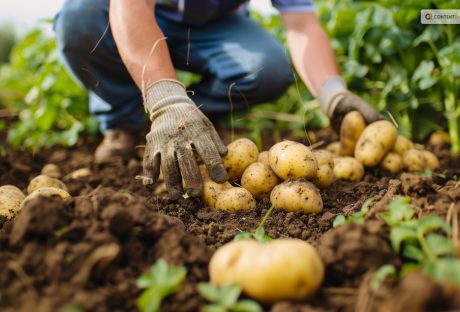A cold winter night with a delicious dish of chili is all you need to enjoy your moment. But wait, Are you left with too much liquid in your chili? Ah! No need to worry at all. There are numerous ways on “how to thicken chili”.
Honestly, you don’t want a thin chili because there is nothing better than a cheerful bowl of thick chili as your winter dish. Many times, just to thicken the chili, people cook it more than it is necessary. Later, other ingredients in it fall apart and turn to mush.
Don’t panic. There are effective and easy ways to thicken chili at your home, and all of these methods are tried and tested. Just be sure to use at least some of these methods to thicken chili before your precious moment turns into sour.
How To Thicken Chili – Tried and Tested

You may be wondering that cooking your dish for a little longer will make your chili thick. But do you know that you are mushing other ingredients in it? So, you must know other effective ways about how to thicken chili. Below listed are the perfect ways to thicken chili for the perfect night.
1. Flour – Standard Thickening Method:
Wheat flour is composed of proteins, sugars, lipids, starch, and enzymes. It is used for making different types of foods. Flour is widely used for thickening chili in most of the kitchens. It really works great. Now its time to try for yourself as well.
Ingredients:
30ml or two tablespoons of flour and 60ml or ¼ cup of cold water.
How to Use?
- Take a separate bowl. Mix flour and water thoroughly in it.
- Make sure that the resulting mixture has no lumps and is smooth.
- Then add the flour mixture in your thin chili while cooking it in medium-high heat.
- Stir constantly. Let the mixture boil and thicken well. It will hardly take few minutes.
- Make sure to continue stirring an additional few seconds to see if you are able to detect flour in your chili flavor.
So, here is your hearty chili dish! Now, it is much thicker and tastier than before. You can even serve this to your guests.
2. Arrowroot- Best Thickening Agent:
Arrowroot contains Vitamin B, Iron, Potassium, low-protein, starch, etc. It is widely used as a thickening agent in all household kitchens. It is a starch that is extracted from the arrowroot plant. When you will use arrowroot in your dish, then it will give an amazing surface gloss to your liquid chili.
Ingredients:
5ml or 1 tablespoon of Arrowroot and 5ml or 1 tablespoon of cold water.
How to Use?
- Take a separate bowl. Mix thoroughly water and arrowroot to turn it into a smooth paste.
- Make sure that you add only a small amount of arrowroot as it is potent and flavorless.
- Then add slurry into your thin chili cooking it in medium heat.
- Stir constantly below the boiling point.
- Then after 1 to 2 minutes, your thin chili will thicken instantly.
Arrowroot adds gloss like appearance to your chili dish making your dish thicker and delicious. I have used this method and got the result, so now it’s your time!
3. Cornstarch- Anti-sticking Agent:
Cornstarch is also known as Maize starch which is extracted from the maize grain. It is a food ingredient that is used in thickening soups and sauces. Cornstarch gives a moderate glossy appearance and when mixed with liquid, it rearranges itself.
Ingredients:
15ml or 1 tablespoon of cornstarch and 15ml or 1 tablespoon of cold water.
How to Use?
- Take a separate bowl. Mix thoroughly cornstarch and water before mixing it to chili.
- After adding cornstarch paste to chili, heat it in a medium to high flame.
- Stir it well until the bubbles start appearing.
- Wait for few minutes to see the results.
- If you still feel that your chili should be thicker then you can add more cornstarch and water on it.
- Then let it cook for an additional few minutes.
You can use cornstarch to thicken your chili because it will not alter the taste of your dish of chili as cornstarch is flavorless.
Other Simple Ways to Thicken Your Thin Chili:
4. Mix it in Tomato Paste
Now, no need to worry about how to thicken chili. If you want your chili only a little thick then you can use this method. Tomato is one of the main elements in chili. So adding it to your mixture won’t alter its taste and makes your chili thicker.
Ingredients:
170 grams of tomato paste.
How to Use?
- I am suggesting that you should use fresh handmade tomato paste.
- Since tomato paste is recognized as bitter in taste, so you can add a pinch of sugar in it.
- Sugar will add a mild sweetness to your dish by removing tomato’s bitterness.
- During the final thirty minutes of cooking add 170 grams of tomato paste into your thin chili.
- Slowly add tomato paste to your thin chili. You can also add it after every ten minutes if you wish (⅓ of the tomato paste).
- Stir constantly to combine it well.
You can use tomato paste to thicken your thin chili dish. But keep all the instructions in mind so as not to make any mistakes while preparing it.
5. Use More Beans to Thicken Your Thin Chili:
A bean is a seed of numerous genera of the flowering plant. They have the ability to curl up on any medium. Beans can be use to thicken your thin chili. Do you know that India is the largest producer of dry beans in the world? Yes, it is.
Ingredients:
125ml or a half-cup beans.
How to Use?
- If your chili contains beans then strain half cup of beans. Then refry and blend it.
- Then again mix this mixture to your chili and cook for a few minutes.
- Stir occasionally to warm it well.
- You can use canned or home-cooked beans as per your wish.
- If you still feel that your chili is thin, you can add extra beans in it but make sure you blend it well.
Here you go! Your thick chili dish is ready now to serve your family. If you don’t like beans then no need to worry. You can add meats to make your chili thicker.
Wrapping it Up
“How to thicken chili” is one of the major problems for all the cook masters. Even I have used many methods to thicken my thin chili but all went in vain!
Therefore, all the above methods are tried and tested about how to thicken chili. So, you can use it to thicken your thin chili. I know nobody likes to serve thin chili to their family or guests. Even I don’t like it. Do you?
Image source: wikihow
Read Also:



























